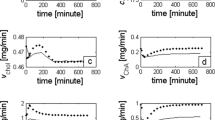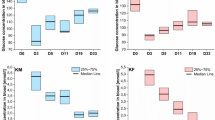Abstract
Male Wistar rats fed a normal laboratory pelleted diet, when treated s.c. with 1,2-dimethylhydrazine (DMH) 10 mg/kg/wk survived the 24-week experiment, showed no signs of chemical toxicity or macroscopic liver damage, and developed mainly large-bowel tumours. Conversely, male Wistar rats treated with 20 mg/kg/wk DMH did not survive the full term of the experiment and developed ascites, pleural effusions and nodular livers. They also developed more small-bowel tumours than large-bowel tumours. The relationship between the predominant site of tumour development and dosage of DMH was highly significant.
Male Wistar rats fed with an all-liquid diet (Vivonex) and treated with 20 mg/kg/wk DMH behaved quite differently both in terms of survival and site of tumour development. These rats survived the full term of the experiment, showed no signs of chemical toxicity, experienced minimal liver damage and developed predominantly large-bowel tumours. The protection afforded by the all-liquid diet against DMH toxicity and small-bowel tumour induction was statistically highly significant.
A series of blood tests with special reference to liver function confirmed the highly significant degree of protection against liver damage afforded by the all-liquid diet.
Sections of liver from treated rats were examined, and a simple pathological scoring system was devised which showed a highly significant difference in liver histology between standard diet and liquid-diet rats treated with 20 mg/kg/wk DMH.
The results strongly suggest an association between severity of liver damage from DMH and the subsequent development of small-bowel tumours. The all-liquid diet protected rats from liver damage and these rats developed significantly fewer small-bowel tumours.
This is a preview of subscription content, access via your institution
Access options
Similar content being viewed by others
Rights and permissions
About this article
Cite this article
Castleden, W., Shilkin, K. Diet, liver function and dimethylhydrazine-induced gastrointestinal tumours in male Wistar rats. Br J Cancer 39, 731–739 (1979). https://doi.org/10.1038/bjc.1979.127
Issue Date:
DOI: https://doi.org/10.1038/bjc.1979.127
This article is cited by
-
Acute changes occurring in the intestinal mucosae of rats given a single injection of 1,2 dimethylhydrazine
Virchows Archiv B Cell Pathology Including Molecular Pathology (1981)



